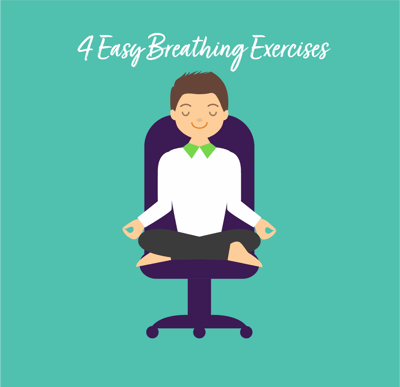 Sometimes, you just need to take a breather and let go of stress.
Sometimes, you just need to take a breather and let go of stress.
Studies show the majority of stress most Americans feel comes from their job. High-pressure deadlines, agitating colleagues, and too much work can all contribute to daily work stressors.
Too much stress comes at a cost, of course.
Workers with high-levels of stress are more likely to have an increased risk of hypertension, heart attack risk, and other disorders like insomnia. While stress can take a physical toll on employees, there are ways to alleviate it, too.
Wellness programs focused on stress relief like deep breathing exercises can help.
Breathing exercises are:
- Easy to learn
- Don’t require special equipment
- Can be done anywhere
This post will outline breathing exercises that will help employees stay mindful of their breathing throughout the day.
The Cost of Stress at Work
A National Institute for Occupational Safety and Health (NIOSH) study found that a quarter of employees report the most stressful thing in their life is their work.
Unfortunately, health issues are related to job stress more than any other life condition. What’s worse, long term exposure to stress can lead to severe issues like cardiovascular disease, back problems, musculoskeletal disorders, and psychological problems.
Work-related stress has other ripple effects, too:
- Workers who report high levels of stress spend 50% more on healthcare
- Workers under high levels of stress are less productive and present
- Stressed-out employees are more likely to resign
It is estimated that stress related costs for U.S. businesses are over $300 billion a year. With such high stakes and high costs, it’s important for employers to focus on ways to encourage stress-relief in any way possible and minimize burnout.
How Stress Impacts Our Breath
When we’re stressed we tend to take shallow breaths. This air stays in the top third of our lungs. This is a problem since the bottom part of our lungs is what supplies most of the oxygen and nutrients to our body. This can lead to employees feeling less alert, more tired, and decrease cognitive ability.
Why focus deep breathing for stress?
Deep breathing can help workers feel more centered. It can also improve posture, reduce inflammation, and help employees feel calmer and more alert.
Breathing Exercises to Reduce Stress
Our breath is what gives our cells oxygen and gives us energy. Too many times stressed-out individuals take short, shallow breaths without even realizing it. Doing so can increase anxiety and reduce energy.
Deep breathing, on the other hand, increases focus and lowers heart rate while also inducing a sense of calm and control.
Here’s a look at four easy-to-do breathing exercises to improve energy and mood:
Deep Breathing
Get comfortable. This breathing technique will probably come more naturally than all of the other techniques. Similar to when your doctor asks you to breathe deeply during a chest exam, you’ll find this technique engages your mind and breath fully.
Here’s how to do it:
- Breathe in through your nose until your belly fills with air
- Breathe out slowly through your nose
- Put one hand on your chest and the other on your belly and breathe in
- The hand on your stomach should rise more than the one on your chest
- Breathe out and feel your belly lower
- Repeat three more times
Dr. Weil’s 4-7-8 Breathing Method
Dr. Andrew Weil, a Harvard graduate and founder of the Universityof Arizona Center for Integrative Medicine, teaches this method frequently. He believes it can help with falling soundly asleep and anxiety reduction.
Here’s how to do it:
- Count to 4 while breathing in deeply through your nose
- Note your belly should expand
- Count to 7 while holding that deep breath
- Count to 8 slowly while exhaling through your mouth
- Repeat four more times
Breath Focus
Focusing on your breath can help you push other anxious thoughts out of your mind. It allows you to concentrate solely on your breath and filling your lungs fully.
Here’s how to do it:
- Take a few deep breaths to get started
- Imagine you are breathing in calm and goodness
- When you breathe out, imagine you are exhaling your negativity and stress
- Continue for several minutes
Equal Breaths
As you practice this technique, you’ll be able to increase your inhale and exhale count. This exercise allows you to really focus on breathwork and keeping a “balance” within your diaphragm,
Here’s how to do it:
- Inhale and exhale for the same count
- Start with a slow count of five in
- Exhale for another slow count of five
- Repeat for several minutes
Try Deep Breathing for Stress Relief Today
One of the best parts of using any of these breathing exercises to reduce stress is you’ll immediately feel better.
Stress relief comes in many forms, and sometimes you just can't get away from the office or stressful situation fast enough.
Breathing techniques are a tool a person can easily control no matter their location.
It’s important to recognize stress-related issues and help your employees find ways to mitigate stress at work. Deep breathing techniques can be used by anyone, and it doesn’t take special training to do it, either.
Share these four breathing techniques with your employees today as a resource they can rely on whenever they feel stress building. There’s no eliminating stress, but there are ways to reduce it.
Breathing is just one way to do it!
What are your favorite deep breathing exercises? Share in the comments below!



